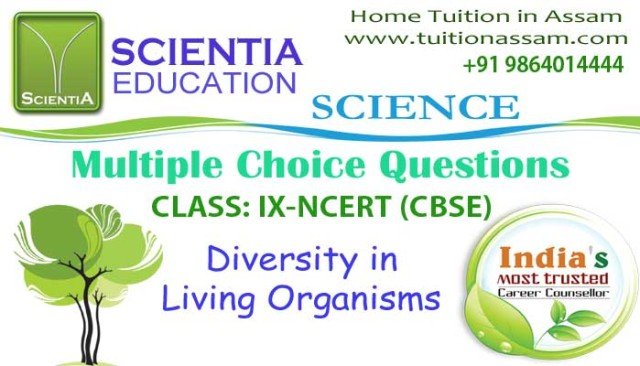
CLASS: IX NCERT (CBSE)
BIOLOGY
Diversity in Living Organisms
Question (1): The science of classification is called
1. demography
2. taxonomy
3. biology
4. none of the above
Ans: 2
Question (2): Homo: generic name :: sapiens: ________.
1. species name
2. human name
3. division name
4. organism name
Ans: 1
Question (3): Who is the Father of Taxonomy?
1. Carolus Linnaeus
2. Eichler
3. E.H. Haeckel
4. Robert Whittaker
Ans: 1
Question (4): Radial symmetry is found in _________.
1. protozoa
2. coelenterata
3. flatworms
4. arthropoda
Ans: 2
Question (5): Protochordates consist of _______ and _______.
1. urochordata and cephalochordata
2. urochordata and vertebrata
3. cephalochordata and vertebrata
4. none of the above
Ans: 1
Question (6): Sub-phylum urochordata includes _____.
1. amphibians
2. marine animals
3. terrestrial animals
4. all of the above
Ans: 2
Question (7): The class Aves have all the following features except that their
1. fore limbs are modified into wings
2. respiration is not through lungs
3. heart is 4 chambered
4. skeleton is light
Ans: 2
Question (8): In phylum Aschelminthes, the alimentary canal is
1. complete
2. incomplete
3. not present
4. none of the above
Ans: 1
Question (9): An example of phylum Echinodermata is
1. prawn
2. starfish
3. octopus
4. apis
Ans: 2
Question (10): Chondrichthyes are also called
1. cartilaginous fish
2. bony fish
3. lamprey
4. creeping vertebrates
Ans: 1
Question (11): Binomial nomenclature was introduced by
1. John Ray
2. A. P. de Candolle
3. A. L. de Jussien
4. Carolus Linnaeus
Ans: 4
Question (12): A group of freely inter-breeding organisms constitutes a
1. species
2. genera
3. family
4. class
Ans: 1
Question (13): Which taxonomic term may be substituted for any rank in the classification?
1. Class
2. Genus
3. Species
4. Taxon
Ans: 4
Question (14): In Whittaker’s classification, unicellular organisms are grouped under
1. protista
2. porifera
3. fungi
4. protozoa
Ans: 1
Question (15): The algal partner of a lichen is called
1. mycobiont
2. phycobiont
3. both A and B
4. none of the above
Ans: 2
Question (16): ‘Venus flower basket’ is the dried skeleton of
1. euspongia
2. euplectella
3. spongilla
4. leucosolenia
Ans: 2
Question (17): Choanocytes are unique to
1. protozoa
2. porifera
3. mollusca
4. echinodermata
Ans: 2
Question (18): Mesoglea is characteristic of
1. platyhelminthes
2. aschelminthes
3. cnidaria
4. mollusca
Ans: 3
Question (19): In platyhelminthes, the excretory organs are
1. nephridia
2. malpighian tubules
3. flame cells (solenocytes)
4. green glands
Ans: 3
Question (20): The body cavity of arthropoda is
1. pseudocoel
2. coelom
3. haemocoel
4. acoelom
Ans: 3
Question (21): Respiration in arthropods occurs through
1. gills
2. book lungs
3. trachea
4. all the above
Ans: 4
Question (22): Spiders and scorpions are
1. insects
2. millipedes
3. arachnids
4. crustaceans
Ans: 3
Question (23): Hag fish is the common name of
1. octopus
2. balanoglossus
3. myxine
4. peteromyzon
Ans: 3
Question (24): Elasmobranchs do not have
1. placoid scales
2. gill-slits
3. notochord
4. operculum
Ans: 4
Question (25): What is the scientific name of the National bird of India?
1. Psittacula eupatra
2. Passer domesticus
3. Pavo cristatus
4. Corvus splendens
Ans: 3
Question (26): Birds differ from bats in absence of
1. homeothermy
2. four-chambered heart
3. tracheae
4. diaphragm
Ans: 4














